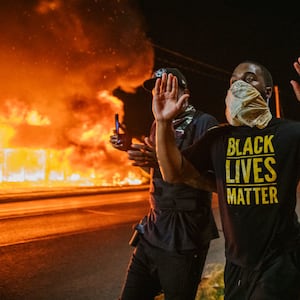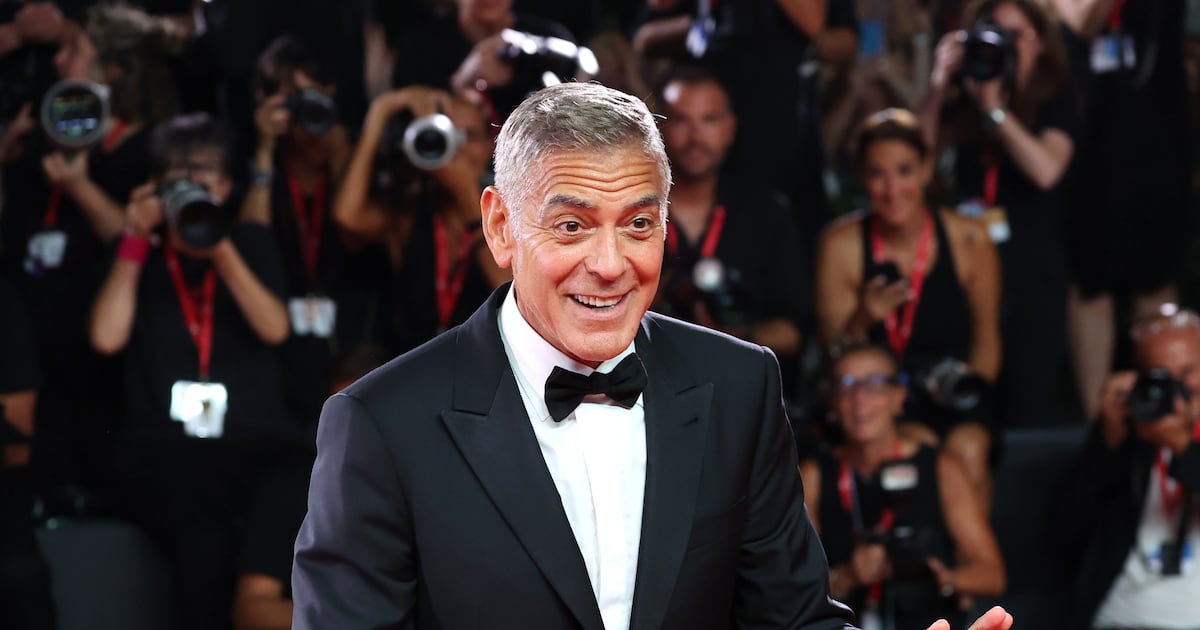Before Jacob Blake was shot at least seven times in the back on Sunday night, the Kenosha, Wisconsin police department had long been plagued by aggressive officers, claims of corruption, and a lack of accountability—including the grisly beating of two teenagers on video and a fatal shooting by a cop who was on his first day back at work after another shooting.
“Corruption, lies, multiple evidence plantings, and deceit existed throughout the entire Kenosha criminal justice system,” concluded one report, commissioned by the Wisconsin state Supreme Court in 2017 after officers allegedly lied and planted evidence in a murder case.
Bystander video that appeared to show a Kenosha cop shooting Blake at point-blank range as he tried to get into a van with his children on Sunday prompted protesters to take to the streets in outrage, with some setting fires and vandalizing parts of the city.
ADVERTISEMENT
“We want justice, and we’re going to get justice," Justin Blake, the 29-year-old’s uncle, told CNN on Tuesday. "We’re going to demand justice, but we're going to do that without tearing up our own communities."
Herman Poster, Blake’s cousin, told The Daily Beast the 29-year-old was “paralyzed from the waist down” and was in surgery on Tuesday morning to see if doctors could “get some nerves to work.” Blake’s father, Jacob Blake, told the Chicago Sun-Times that his son had “eight holes” in his body and doctors didn’t know if the injuries would be permanent.
“They’re saying it’s a 50/50 chance he’ll walk away,” Poster, 33, told The Daily Beast, adding that Blake is “pulling through.”
But while Blake’s family remains hopeful, the shooting shines a new spotlight on the Kenosha Police Department, where 89 percent of officers are white, shootings and beatings often go without punishment, and outsider investigators claim corruption is rife. Officers have usually gotten little more than a slap on the wrist for violent encounters.
According to FOX6, two males were hanging around Lincoln Park on Memorial Day in 2015 when two Kenosha police officers approached them to ask about a garbage can that had been kicked over.
The Kenosha Police Department said one immediately began acting disorderly, spurring a physical altercation when one officer tried to put him under arrest. Despite family members’ assertion that the pair were teenagers, Kenosha Police Chief John Morrissey insisted they were adults—and that one had “jumped” on the officer.
However, a video showed at least eight officers surrounding the two on the ground, and some officers repeatedly throwing punches.
The incident occurred just two months after a Kenosha police officer fatally shot a 26-year-old following a car chase—on his first day back from mandatory leave for shooting another suspect.
Officer Pablo Torres, who was put on administrative leave for 10 days after shooting a suspect armed with knives on March 4, 2015, fatally shot Aaron Siler 14 days later. Authorities said Siler, who was wanted on a felony probation and parole warrant, confronted Torres with a weapon before Torres fired his weapon.

Several buildings were burnt in central Kenosha.
Brandon Bell/GettyAccording to a federal excessive force lawsuit filed against Torres, obtained by The Daily Beast, Torres shot Siler, 26, six times then didn’t attempt to provide any lifesaving measures. The lawsuit also alleged that every Kenosha Police officer, including Torres, wasn’t provided adequate de-escalation training. The department maintained a policy of failing to discipline those “engaging in misconduct, including, but not limited to, uses of excessive force,” it said.
“KPD officers using force against individuals are recurring situations that present an obvious potential for constitution rights violations,” the lawsuit stated. “Torres failed to attempt to de-escalate the situation with Aaron Siler.”
The suit also detailed Kenosha’s “long history of constitutional rights violations” stemming from 1999, including several aggressive drug-related arrests. In one 2002 incident, two officers allegedly used pepper spray and a taser stun gun on Lloyd King, who was being arrested for a drug-related offense.
In an incident report, the two officers claimed they only used the Taser on King once, though records later showed the stun gun was used multiple times. King later received $75,000 for the excessive arrest. The federal district court issued a partial summary judgment in Siler’s case, which relieved him from liability for the 2015 shooting.
Officers also appeared to lie after the fatal shooting of Michael Bell, Jr., who was killed outside his home on Nov. 9, 2004, after a night out with friends. While officers claimed the 21-year-old reached for an officer’s holster—prompting the second cop to shoot him several times—there were no DNA or fingerprints on the gun or holster to prove the claim.
Bell’s father, Michael, a retired lieutenant colonel in the U.S. Air Force, wrote in a Politico op-ed that the officers were immediately cleared of wrongdoing. In 2010, Bell won a $1.75 million lawsuit against the City of Kenosha and filed multiple complaints and open records requests against the police department. Bell used most of the money on police reform advocacy and was instrumental in pushing legislation that made Wisconsin the first state to require any in-custody death to be investigated by an outside agency. In 2018, Bell took out a full-page Washington Post ad calling on police to reopen his son’s case.
The shocking conduct goes beyond police brutality. In 2017, the Wisconsin state court opened an investigation after the former Kenosha County district attorney allegedly failed to disclose information about an officer who planted evidence in a murder case and neglected to admit that another officer’s testimony, in which he said he had no “personal knowledge” of the fake evidence, was false.
“When all the evidence was in it became clear that the entire Kenosha law enforcement team [was] acting improperly,” the final report by state-assigned attorney Dennis Flynn stated.
And despite Kenosha’s leadership unanimously endorsing the use of body-worn cameras in 2017, officials balked at the price tag and never bought any. Officials are now stressing body-worn cameras will be in the budget for 2022, more than five years later.
According to a 2018 U.S. Department of Justice study, the decision not to follow through with the body-cam approval further put Kenosha behind most other mid-sized police departments in the country. In 2016, roughly 56 percent of police departments with between 100 and 250 officers had body-worn cameras to increase transparency and accountability.
Kenosha continued to demonstrate force on Monday evening, deploying tear gas on dozens of protesters gathered in the heart of the city. In response, residents hurled water bottles and bricks at officers. Anticipating further protests on Tuesday, authorities on Monday deployed the Wisconsin National Guard and instituted a city-wide curfew.

Law enforcement deployed tear gas on protesters on Monday night.
Stephen Maturen/Reuters“We are thankful for the response and for people looking out and taking to the streets about what happened to my cousin,” Poster told The Daily Beast, describing Blake as a “peacemaker” who is not “disrespectful.”
The Kenosha Police Department has released few details about the shooting, but noted officers were responding to a domestic incident at 5:11 p.m. on Sunday before they “were involved in an officer-involved shooting.” In the video, Blake can be seen walking to his car while being followed by two officers with their guns drawn. As he opened the driver’s side door, one officer grabbed his shirt, while the other fired at least seven shots at Blake’s back.
Civil rights attorney Benjamin Crump, who is representing the Blake family, said Blake was trying to break up a fight before the shooting, which was witnessed by his three sons from inside the car. Poster confirmed his younger cousin was “trying to break it up” and believed that when “police came they probably thought it was him that was involved.”
“Normally he doesn’t get into other people’s business but if he saw a fight, he would have tried to help and break it up,” the cousin said. “He would never start anything though.”
Poster said that when he arrived at Froedtert Hospital in Milwaukee on Sunday, he saw his cousin’s three sons, who looked “confused” and “scared.” The two police officers involved have since been placed on administrative leave.
Wisconsin Attorney General Josh Kaul said Monday the state’s Justice Department was “vigorously” investigating the shooting and “will unwaveringly pursue justice,” however they would not be releasing the identity or number of officers involved in the incident.
The federal Department of Justice on Tuesday also confirmed they are aiding in the investigation.
Kenosha Police Department did not respond to a request for comment.






